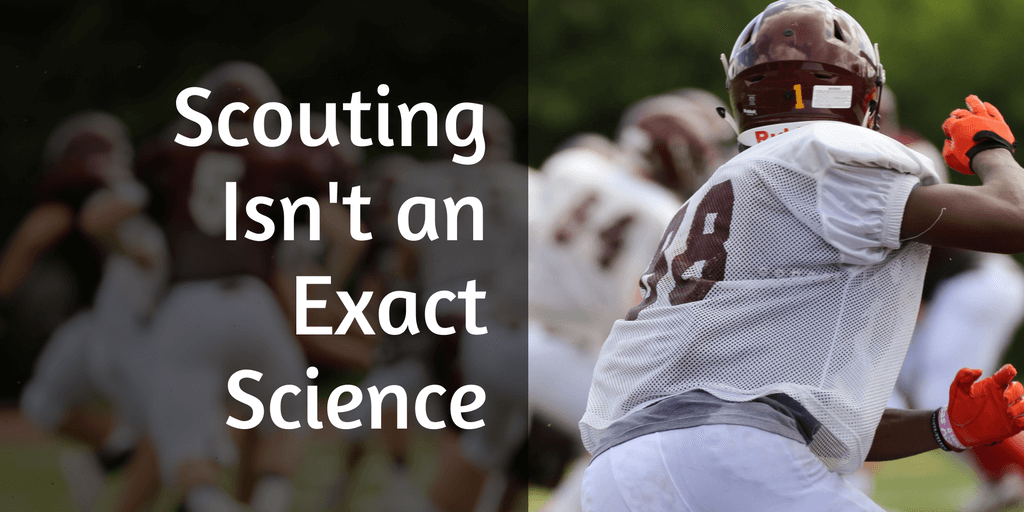Think back to the 1998 NFL draft, the clash of the two future NFL MVPs battling for the coveted position of the first overall draft pick. One–the man who wound up going first, was Peyton Manning, five-time NFL MVP and 14 time Pro Bowler. The other was Ryan Leaf, whose 14:36 TD:interception ratio has solidified him as one of the biggest draft busts of all time.
When draft day rolls around every year there is bound to be a number of busts that will be highly scouted, highly touted, and ultimately ineffective. Remember Trent Richardson? Or Brady Quinn? How about JaMarcus Russell? Everyone remembers JaMarcus Russell, most famous for his ability to throw the ball very, very far, then for showing up to training camp weighing 300 lbs.
In the causes of Leaf, Russell, Richardson and countless others, scouting failed miserably. Scouting professional athletes is an incredibly intricate and delicate process, and a whole lot goes into it, some measureable, some not so much.
The Numbers
Amateur scouts (read: fans) everywhere start and end their scouting reports here more often than not. Looking at stats from college days and the NFL scouting combine are great places to start, but hardly the be all end all when it comes to scouting an NFL player.
We’ve seen before that players that succeed immensely in college can fail spectacularly at the NFL level–so stats are by no means the final determiner of what success in the NFL looks like. But college stats and, perhaps moreso, the NFL combine represent a great spot to start–a player’s 40 yard times indicate his speed, while the shuttle and cones are good indicators of quickness and agility.
Intangibles
Intangibles are the pieces of a player that you can’t measure–essentially, the aspects that lead to the downfall of guys like Johnny Manziel. Both personality traits (hard to work with, stubborn, lazy) fall under intangibles, as do finer details of their game, like game intelligence and leadership.
While Manziel may have had the athletic ability and even the smarts to play football at a high level, his attitude of “party first, football later” got him in trouble on and off the field far too often for him to be an effective.
One of the downfalls of players like the highly touted Robert Griffin III in addition to his rich history of injuries, was (and is) his inability to read defenses. Griffin was a hard worker, athletic and intelligent, but his football IQ struggled at the NFL level.
Leadership is a big piece of the intangible puzzle in addition to attitude and IQ– leadership can’t be taught, but must be instilled before an athlete reaches the professional level to have a big impact. Leadership and accountability aren’t often discussed on the football field but are incredibly important, especially for quarterbacks.
The Tape
They say that you shouldn’t buy a car before you test drive it, and the same goes for QBs–don’t draft one unless you’ve seen him play. Numbers and intangibles can represent some of the more important aspects of what separates a perennial pro-bowler from a bench warmer, but watching the man play can shed light on mechanical issues, body type and potential injury threats or footwork issues.
The Scale
Most NFL scouts use a scale that ranges from 1-9 to grade players pre-draft. Anything below 5.5 is player who will likely go undrafted–perhaps they were skilled in college but ultimately won’t succeed in the NFL. A 6.0 is a solid player who could make an impact, while a 6.5 indicates that the player will likely be a starter. A 7.0 is a Pro Bowler, and an 8 is a dominant force. The final number on that scale, a 9, is almost never given out–it indicates generational talent, players like Bo Jackson.
As with the evaluation of most everything and everyone in the world, a good bit of scouting boils down to subjectivity. People have made attempts to remove any bit of opinion from scouting (check out Moneyball, the book/movie about the Oakland A’s trying to build a cheap team of players by ignoring traditional scouting metrics). No matter how hard we’ve tried since the first NFL draft back in 1936, there will always be busts.

